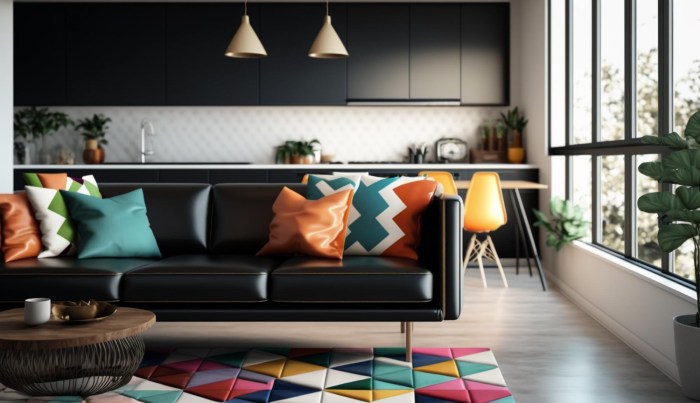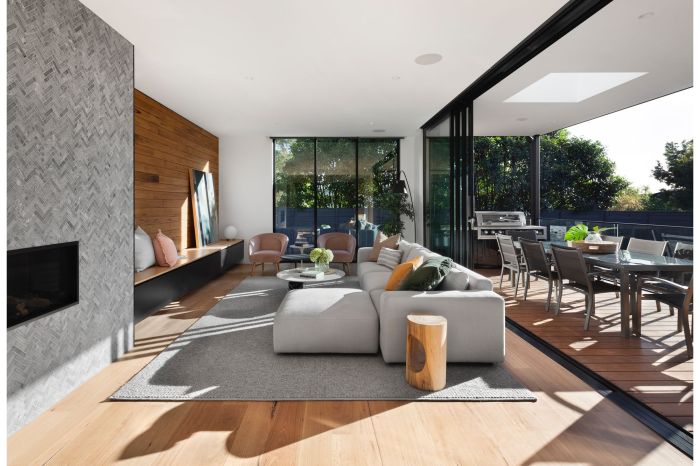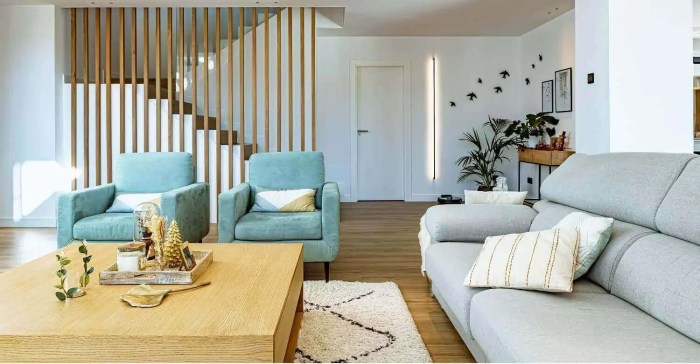Crafting Stunning Interiors by Design: A Comprehensive Guide
As interiors by design takes center stage, this opening passage beckons readers into a world crafted with good knowledge, ensuring a reading experience that is both absorbing and distinctly original.
Interiors by Design is a unique approach to interior decorating that focuses on creating harmonious spaces through thoughtful design choices. From color schemes to furniture selection, every element is carefully curated to achieve a cohesive and visually appealing result.
Introduction to Interiors by Design
Interiors by Design refers to a style of interior decorating that focuses on creating spaces that are both functional and aesthetically pleasing. This design approach prioritizes the use of color, texture, and furniture to enhance the overall look and feel of a room.
Unlike other interior design styles that may prioritize trends or specific themes, Interiors by Design is more about creating a timeless and harmonious space that reflects the personality and preferences of the occupants.
Principles of Interiors by Design
- Balance: Interiors by Design strives for visual equilibrium in a space by distributing visual weight evenly.
- Harmony: The design elements in a room should work together cohesively to create a sense of unity.
- Proportion: Ensuring that the size and scale of furniture and decor items are appropriate for the space.
- Rhythm: Creating a sense of movement and flow in a room through repeated patterns or colors.
- Emphasis: Highlighting a focal point in a room to draw attention and create interest.
Elements of Interiors by Design

When it comes to designing interiors, there are several key elements that play a crucial role in creating a cohesive and visually appealing space. These elements include color schemes, furniture selection, decor choices, lighting, and the use of textures and patterns.
Color Schemes
Color schemes are essential in setting the mood and atmosphere of a room. Whether you opt for a monochromatic palette for a minimalist look or bold contrasting colors for a statement, the choice of colors can greatly impact the overall design aesthetic.
Furniture
The selection of furniture is not only important for functionality but also for style. The type of furniture chosen should complement the overall design theme and provide both comfort and visual interest to the space.
Decor
Decor items such as wall art, sculptures, plants, and other accessories add personality and character to a room. These decorative elements can tie the design together and create a cohesive look.
Importance of Lighting
Lighting is a crucial element in interiors by design as it can dramatically affect the ambiance of a room. Proper lighting can highlight architectural features, create focal points, and enhance the overall design aesthetic.
Textures and Patterns
Textures and patterns add depth and interest to a space. Whether through the use of textured fabrics, patterned wallpaper, or intricate tile work, incorporating different textures and patterns can elevate the design and create a visually stimulating environment.
Colors and Mood in Interiors by Design
When it comes to designing interiors, colors play a crucial role in setting the mood and atmosphere of a space. Different colors have the power to evoke specific emotions and feelings, making them a key element in interior design.
Impact of Colors on Mood
- Warm colors like red, orange, and yellow tend to create a cozy and inviting atmosphere. They can stimulate energy and promote social interaction in spaces like living rooms or dining areas.
- Cool colors such as blue, green, and purple are known for their calming and soothing effects. These hues are ideal for bedrooms or relaxation areas, promoting a sense of tranquility and peace.
- Neutral colors like white, beige, and gray offer a versatile base for any room. They can create a clean, timeless look and provide a sense of balance and harmony in the design.
Color Combinations in Interiors by Design
- A classic combination of black and white can create a sophisticated and elegant look in interiors. This timeless duo adds contrast and drama to any space.
- Complementary colors, such as blue and orange or purple and yellow, create a vibrant and dynamic feel. These pairs work well in spaces where you want to make a bold statement.
- Analogous colors like green and blue or yellow and orange offer a harmonious blend that is pleasing to the eye. These combinations create a sense of unity and cohesion in the design.
Choosing Colors Based on Function
- For a productive workspace, consider using energizing colors like yellow or green to promote creativity and focus.
- In a bedroom, opt for calming shades of blue or lavender to create a peaceful environment conducive to relaxation and sleep.
- For social areas like the living room, warm tones such as red or orange can encourage lively conversations and a welcoming ambiance.
Furniture Selection in Interiors by Design
When it comes to designing a space, furniture selection plays a crucial role in enhancing the overall aesthetic and functionality of a room. The right furniture pieces can set the tone for the design style, create a cohesive look, and provide comfort for the occupants.
Importance of Scale and Proportion
Scale and proportion are key considerations when selecting furniture pieces for a room. Furniture that is too large or too small for a space can throw off the balance and harmony of the design. It is essential to choose furniture that fits the scale of the room and complements the proportions of other elements in the space.
For example, a large sectional sofa would overpower a small living room, while a delicate side table might get lost in a large open-concept space.
Tips for Mixing Different Furniture Styles
Mixing different furniture styles can add visual interest and personality to a room, but it requires careful consideration to maintain a cohesive look. One way to mix styles successfully is by choosing a common element, such as color or texture, to tie the pieces together.
For example, mixing a modern leather sofa with a traditional wooden coffee table can work well if both pieces share a similar color or finish.Another tip is to vary the scale of the furniture pieces to create visual contrast and depth in the room.
Pairing a large, statement-making piece with smaller, more delicate pieces can create a dynamic and balanced composition. Additionally, consider the overall mood and style of the room when mixing furniture styles to ensure that the pieces complement each other and contribute to the desired aesthetic.By keeping scale, proportion, and style in mind when selecting furniture pieces, you can create a harmonious and visually appealing interior design that reflects your personal taste and enhances the functionality of the space.
Decor and Accessories in Interiors by Design

Decor and accessories play a crucial role in enhancing the overall aesthetic appeal of an Interiors by Design space. From artwork to rugs and plants, these elements can add personality and style to the room. Let's delve into how to incorporate these decor pieces effectively.
Incorporating Personal Touches
When it comes to adding personal touches to your interiors, consider displaying family photos, travel souvenirs, or handmade items that hold sentimental value. These pieces not only reflect your personality but also create a sense of warmth and uniqueness in the space.
- Hang a gallery wall with a mix of framed photos and artwork to showcase your memories and interests.
- Place decorative objects such as vases, sculptures, or figurines that resonate with your personal style on shelves or side tables.
- Integrate handmade items like crocheted blankets, pottery, or DIY crafts to add a personal touch to the decor.
Balancing Minimalism with Decorative Accents
Achieving a balance between minimalism and decorative accents is key to creating a visually appealing and harmonious interior design. While minimalism focuses on simplicity and clean lines, adding carefully selected decor pieces can bring warmth and character to the space without overwhelming it.
- Choose a neutral color palette for the walls and furniture to create a clean backdrop for decorative accents to stand out.
- Opt for statement pieces like a bold artwork or a vibrant rug to add visual interest to a minimalist space.
- Incorporate plants and greenery to bring life and freshness to the room while adding a natural element to the decor.
Layout and Spatial Planning in Interiors by Design

Space planning plays a crucial role in creating functional interiors that not only look good but also serve a purpose. By strategically organizing furniture and decor, designers can optimize the layout of a room to enhance both aesthetics and usability.
Significance of Space Planning
Effective space planning ensures that every inch of a room is utilized efficiently, taking into consideration the flow of movement, natural light, and functionality of the space. It involves determining the best placement of furniture, creating designated areas for different activities, and maximizing visual appeal while maintaining practicality.
Tips for Optimizing Room Layouts
- Consider the function of the space: Before arranging furniture, identify the primary purpose of the room to determine the layout that best suits the activities that will take place.
- Measure and plan: Take accurate measurements of the room and existing furniture to plan the layout effectively, leaving enough space for circulation and avoiding overcrowding.
- Create focal points: Designate a focal point in each room, such as a fireplace, artwork, or statement piece of furniture, to anchor the space and guide the layout around it.
- Zoning areas: Divide the room into zones for different activities, such as seating areas, workspaces, and dining areas, to create a cohesive and organized layout.
- Balance aesthetics and function: Strive to achieve a balance between visual appeal and practicality by arranging furniture in a way that is visually pleasing while also ensuring easy access and functionality.
Creating Flow and Harmony
When planning the layout of a space, it is essential to consider the flow between different areas to ensure a sense of harmony and cohesion. This can be achieved by:
- Creating pathways: Establish clear pathways between furniture and through the room to facilitate movement and prevent obstacles.
- Matching styles: Maintain a consistent design style and color palette throughout the space to create a sense of unity and flow between different areas.
- Balancing proportions: Ensure that the scale and proportion of furniture and decor items are balanced to create a harmonious and visually appealing layout.
- Considering sightlines: Arrange furniture to optimize sightlines and views within the space, taking into account focal points and architectural features.
Closing Summary
In conclusion, Interiors by Design offers a creative and strategic way to transform living spaces into personalized sanctuaries. By understanding the principles and elements that define this style, anyone can elevate their home to new heights of elegance and comfort.
Answers to Common Questions
How is Interiors by Design different from other interior design styles?
Interiors by Design focuses on creating cohesive and harmonious spaces through carefully selected elements, whereas other styles may prioritize different design principles.
What role do colors play in Interiors by Design?
Colors in Interiors by Design impact the mood of a room and can be used to create a specific atmosphere based on the desired effect.
How important is furniture selection in Interiors by Design?
Furniture choices are crucial in enhancing the overall aesthetic of a room in Interiors by Design, as they contribute to the style and functionality of the space.
What are some common decor elements used in Interiors by Design?
Decor elements such as artwork, rugs, and plants are often incorporated to add personality and character to Interiors by Design spaces.
Why is spatial planning significant in Interiors by Design?
Space planning ensures that interiors are not only visually appealing but also functional, optimizing the layout for both aesthetics and usability.